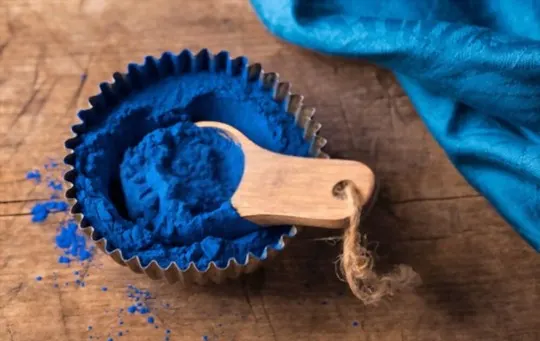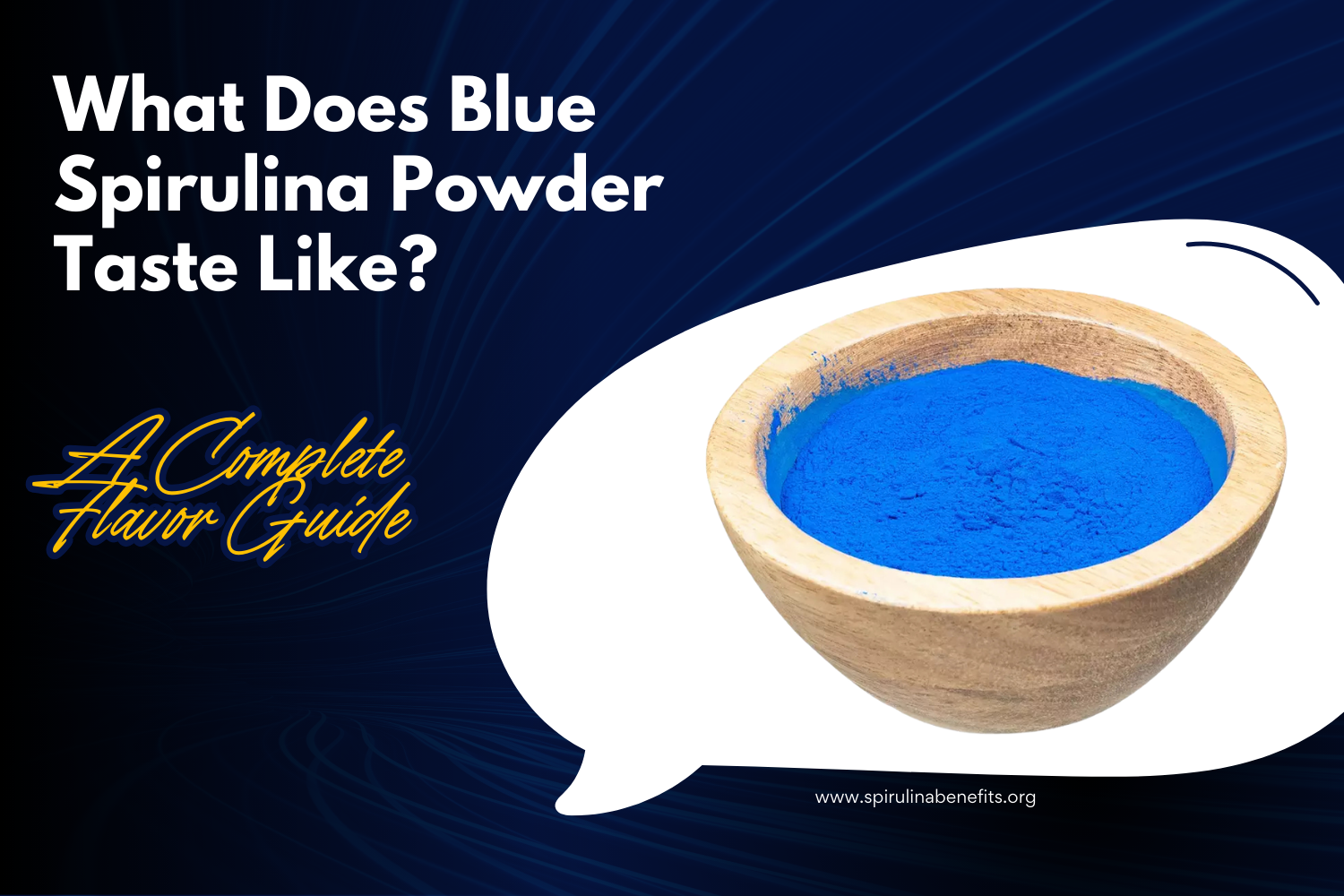If you’re wondering what blue spirulina powder tastes like, you’re not alone. This vibrant superfood has a unique flavor profile that can add a nutritious twist to your smoothies, shakes, and recipes.
Blue spirulina powder is one of the most popular superfoods today, thanks to its impressive nutritional profile and its vibrant blue color. However, one question that often arises is, “What does blue spirulina powder taste like?” Many people who are unfamiliar with this ingredient may be hesitant to try it, unsure about its flavor. In this guide, we will delve deep into the taste of blue spirulina powder, exploring its flavor nuances, how it can be used, and why it’s worth adding to your diet.
Spirulina is known for its earthy, grassy, and somewhat oceanic taste. A pungent fishy aroma or taste can be indicative of poor-quality spirulina. This distinctive flavor is something many individuals find challenging when first introduced to spirulina, especially if they are not accustomed to the taste of algae. As an ancient source of nourishment, spirulina has been recognized for its health advantages by Aztec and African civilizations. Modern scientific studies have validated these claims, cementing spirulina as a popular and valuable addition to any diet.
As it thrives in aquatic environments, the taste profile of spirulina may require some getting used to. However, blue spirulina powder offers a much milder taste compared to its green counterpart. Many users of blue spirulina powder report a flavor that is earthy, mild, and slightly sweet, without the overpowering oceanic or fishy notes often associated with green spirulina. This makes blue spirulina powder a more versatile ingredient in recipes like smoothies, energy bars, or even baked goods.
In recent years, spirulina has emerged as a popular superfood, captivating health enthusiasts worldwide. But a new player has entered the scene: blue spirulina. So, what does blue spirulina powder taste like in comparison to regular spirulina? Unlike its green variant, blue spirulina has a more neutral flavor profile, making it easier for individuals to enjoy its health benefits without the strong aftertaste that is sometimes off-putting. The mild flavor and vibrant blue hue make it a visually appealing addition to various dishes.
This post delves deep into the world of blue spirulina, exploring its origins, benefits, and how it compares to its green counterpart. We’ll also introduce you to BLUwater, an innovative way to enjoy the benefits of spirulina. With BLUwater, you can conveniently enjoy blue spirulina’s health benefits in a refreshing, easy-to-consume form without worrying about the taste.
So, if you’re wondering what does blue spirulina powder taste like, the answer is simple: it’s a mild, earthy, and slightly sweet superfood that’s perfect for anyone looking to boost their diet without the overpowering flavor of traditional spirulina. Whether you’re adding it to your smoothie or experimenting with new recipes, blue spirulina powder is an excellent addition to any health-conscious kitchen.
Health Benefits Of Blue Spirulina: A Superfood Packed with Nutrients
Blue spirulina powder, derived from Arthrospira platensis, is a vibrant, nutrient-dense superfood known for its remarkable health benefits. The primary active component in blue spirulina, phycocyanin, is responsible for its distinctive blue color and many of its health-boosting properties. But beyond its color, you might be wondering what does blue spirulina powder taste like? It has a mild, earthy flavor with slight sweetness, making it an easy addition to various dishes without overwhelming your taste buds. However, the real allure of blue spirulina lies in its incredible nutritional profile, which provides numerous benefits for overall health.
1. Anti-Inflammatory Effects
One of the standout benefits of blue spirulina is its powerful anti-inflammatory properties. Research published in Evidence-Based Complementary and Alternative Medicine suggests that phycocyanin, the pigment found in blue spirulina, has significant anti-inflammatory effects. Chronic inflammation is a contributing factor in many health conditions, including arthritis, heart disease, and even cancer. By incorporating blue spirulina into your diet, you may help reduce inflammation in the body, promoting better long-term health.
2. Immune System Support
Blue spirulina powder is also known for its ability to support the immune system. Thanks to its antioxidant and anti-inflammatory properties, blue spirulina can help strengthen your body’s natural defenses. The phycocyanin in blue spirulina is particularly beneficial, as it can help to combat oxidative stress that weakens the immune system. Additionally, with essential nutrients like Vitamin B12, Iron, and Magnesium, blue spirulina enhances the immune system’s ability to function properly, helping you stay healthy and fight off infections.

3. Neuroprotective Effects
Emerging research indicates that phycocyanin, the active antioxidant in blue spirulina, may offer neuroprotective effects. This means that consuming blue spirulina might support brain health, potentially reducing the risk of neurodegenerative diseases like Alzheimer’s and Parkinson’s. While more research is needed, early studies suggest that the powerful antioxidant properties of phycocyanin can protect the brain from oxidative damage, promoting cognitive function and overall neurological health.
4. Rich in Protein
Spirulina, including its blue variety, is an excellent source of plant-based protein. For vegans, vegetarians, or anyone looking to increase their plant-based protein intake, blue spirulina offers a significant protein boost. A single serving can provide a substantial portion of your daily protein needs, making it an ideal choice for those who want to maintain muscle mass or support body repair after exercise.
5. Packed with Antioxidants
One of the main reasons blue spirulina is so beneficial for health is its high concentration of antioxidants. Phycocyanin not only gives blue spirulina its vibrant color but also acts as a potent antioxidant, helping to neutralize free radicals in the body. By combating oxidative stress, blue spirulina helps protect against chronic conditions such as heart disease, cancer, and aging. Its rich antioxidant content makes it a powerful ally in fighting cellular damage and maintaining overall well-being.
6. Supports Immune Health
Blue spirulina is rich in several vitamins and minerals, including Vitamin B12, Iron, and Magnesium, which are essential for a strong and resilient immune system. These nutrients help the body produce energy, support cellular functions, and maintain healthy red blood cells. By boosting the immune system, blue spirulina can help protect the body from illness and keep you feeling your best year-round.
7. Boosts Energy Levels
Many people report feeling more energized after consuming blue spirulina powder. This is due to its high levels of Vitamin B12 and other energy-boosting nutrients. The body requires B12 for the production of red blood cells and the efficient transport of oxygen throughout the body. With blue spirulina’s ability to support cellular energy production, it’s an excellent choice for those looking for a natural energy boost, whether in the morning to kickstart your day or after a workout to promote recovery.
What Does Blue Spirulina Powder Taste Like?
Blue spirulina powder is often described as having a mild and slightly earthy flavor. Unlike regular spirulina, which can be strong, fishy, or even bitter, blue spirulina is much more palatable and easier to enjoy. Its flavor is subtle, making it a great choice for adding to a variety of recipes without overpowering them.
Spirulina, a type of blue-green algae known for its rich nutrients, usually has an earthy, salty, and sometimes nutty taste. However, the flavor of spirulina can change depending on how it’s consumed and what other ingredients it’s mixed with.
Key Flavor Notes of Blue Spirulina Powder:
- Mild and Earthy: The taste is similar to mild greens or algae, but without the strong oceanic or fishy notes found in other spirulina types. This makes blue spirulina powder much easier to incorporate into your meals.
- Slightly Sweet: Many people notice a subtle sweetness in blue spirulina powder, making it a versatile ingredient for smoothies, juices, and other dishes.
- Neutral: Compared to other superfoods with stronger flavors, blue spirulina is fairly neutral. This makes it easy to blend with different ingredients without changing the taste of your recipe.
Additional Flavor Characteristics:
- Earthy: Spirulina has an earthy, grassy flavor similar to freshly cut grass or algae, which is common in many algae and seaweed varieties.
- Salty: Some people detect a slight salty flavor in spirulina, like the taste of seawater. This can vary depending on the source and growing conditions of the spirulina.
- Nutty: There’s also a subtle nutty undertone to spirulina’s taste, although it’s not as strong as the earthy or salty aspects.
How To Choose The Best Blue Spirulina Powder
When selecting blue spirulina powder, it’s important to choose a high-quality product to ensure you’re getting all the health benefits. Here are some key factors to look for:
- Pure, Organic Spirulina: Choose a product that is free from added sugars, fillers, or preservatives. Pure spirulina ensures you’re getting the most nutrients possible.
- Sustainability: Opt for brands that source their spirulina in an environmentally friendly manner. Sustainable farming practices help protect the planet while providing high-quality spirulina.
- Cold-Processed: Cold processing helps preserve the nutrients and antioxidants found in blue spirulina, keeping the powder as nutritious as possible.
How To Use Blue Spirulina Powder In Your Diet
Wondering what does blue spirulina powder taste like? Its mild, earthy, and slightly sweet flavor makes it easy to add to a variety of dishes. Whether you’re looking for a nutritional boost or a splash of color, here are some great ways to use blue spirulina powder:
1. Smoothies and Shakes
Blue spirulina powder is a great addition to smoothies and protein shakes. Its subtle flavor pairs well with fruits like bananas, mangoes, and pineapples, which help mask the earthy taste. This makes it an easy way to boost your smoothie’s nutritional value without affecting the taste too much.
2. Juices and Water
You can also mix blue spirulina powder into your favorite juices or water. The powder dissolves well, creating a vibrant blue drink that’s both nutritious and visually striking. Whether you add it to lemon water for a refreshing twist or combine it with citrus juices for a tangy beverage, blue spirulina fits easily into your liquid diet.
3. Energy Balls and Bars
For a healthy snack, try adding blue spirulina powder to homemade energy balls or protein bars. When mixed with ingredients like oats, nut butter, and honey, the powder not only boosts the nutritional content but also provides an energy kick throughout the day.
4. Baking
Blue spirulina powder can be used in baking, though it’s not a common ingredient. Try adding it to muffin, pancake, or bread recipes. It enhances the nutritional value and can even add a subtle sweetness, depending on the other ingredients in the recipe.
5. Sauces and Dressings
If you enjoy experimenting with colorful foods, blue spirulina powder can be used to create beautiful sauces or dressings. It works well in creamy dressings for salads or mixed sauces for vegetables. The mild flavor doesn’t interfere with the taste of the dressing, but it adds a stunning blue hue that makes your dishes more exciting.
FAQ
What is the flavor of blue spirulina?
Blue spirulina has a mild, neutral, and slightly earthy taste.
Is blue spirulina yummy?
Yes, it has a subtle taste and blends well with smoothies and juices.
Does blue spirulina taste fishy?
No, unlike green spirulina, it has no fishy or seaweed-like taste.
Who should not take blue spirulina?
People with autoimmune conditions, allergies to algae, or those on certain medications should consult a doctor first.
Can you take blue spirulina every day?
Yes, it is safe for daily use in moderate amounts as part of a balanced diet.

